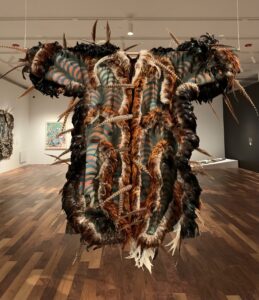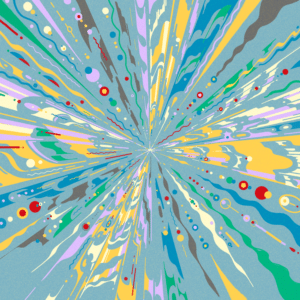Welcome to our American Art Program interview series, where we explore the minds behind museum curation. In each interview, our American Art Program grantees share the curatorial choices behind their exhibitions and how these align with the Henry Luce Foundation’s mission to foreground American art as a catalyst for dialogue and understanding, celebrating creativity, exploring differences, and helping forge common ground. This interview has been edited for clarity and brevity, and an accompanying video takes you on a visual journey.
Jackie Edwards: Why this exhibition? Why now?
Eva Respini: This project with Firelei is very important for us right now. Her work questions history, specifically gaps in history and our understanding of the Americas, including the Caribbean, its relationship with North America, and its connections to Africa and Europe. Her work addresses these gaps and reimagines what history could look like if those gaps were filled in. She accomplishes this through her amazing paintings, which demonstrate virtuosic use of paint, figuration, and a scale reminiscent of historical paintings. In essence, she is creating history paintings for our time, prompting us to reassess the past and look toward a better future.
Jackie Edwards: What inspired you to present this work, to organize this exhibition?
Eva Respini: This exhibition is a continuation of a dialogue I’ve had with Firelei for several years. In 2019, I asked her to do a commission at the ICA Boston at the Watershed, which was eventually presented in 2021 due to pandemic-related delays. After that project, I realized she hadn’t had a major museum survey of her work. This exhibition in Boston, which will also travel to Vancouver and Des Moines, is the first museum look at her 15-year career.
As curators of contemporary art, we often work with an artist and then move on to the next one, but it was important for me to have a sustained dialogue with Firelei. This is the second project I’ve worked on with her, and I feel like I’m really getting to know her practice. She shows how important relationships are in the world of contemporary art, and that it’s not just about concepts and big ideas, but also about the relationships between curators, artists, and the audience. Some have called this “slow curating,” akin to the slow foods movement, emphasizing sustained relationships and dialogue. It’s valuable to be able to follow an artist and have that ongoing dialogue from curator to artist, and this exhibition aims to deliver a meaningful, deep dialogue for the audiences.
Jackie Edwards: Is there a particular audience that you hoped that this project would speak to?
Eva Respini: It’s crucial to broaden the audience for an exhibition. The book accompanying the show allows people who couldn’t attend to engage with the artist’s work. Additionally, the exhibition is traveling to different cities, allowing diverse audiences to connect with the art and have conversations about relevant issues. This is particularly important in Vancouver, where Firelei Baez’s work hasn’t been widely showcased. The exhibition aims to provoke discussions about history, sovereignty, and the identity of the Americas, tailored to each location’s unique perspective. Walking through the galleries in Boston or Vancouver, especially for new viewers, offers an opportunity to discover Firelei’s work and engage in these important conversations.
Jackie Edwards: What is the most essential takeaway of this viewing experience?
Eva Respini: That’s a great question. It’s always difficult to summarize, but I believe Firelei is one of the most important voices in painting today. Her work is luscious, beautiful, and physical. She’s an amazing colorist and a virtuosic painter. She can bring anything to life on canvas. Her engagement with the history of art and painting is relevant, and the sheer beauty and scale of her paintings is something we don’t often see. Another important aspect of her work is how she brings to light histories that have been overlooked or don’t exist in official records. She reimagines history, making up for the gaps in historical narratives, and uses folklore and mythology to understand these untold stories. Her protagonists are primarily women, proudly dominating the canvas, and the scale of her figures is an important part of the meaning in her work.
Jackie Edwards: Is there a personal experience you had with this artist and works that will remain with you?
Eva Respini: In 2015, I first encountered Firelei’s large-scale work at a solo exhibition at the Perez Museum in Miami. The exhibition featured a sculpture/painting at its center, resembling an architectural arch and set for theater, with a painted surface resembling a giant, aged, and torn wallpaper. The piece was a reference to Sans Souci, the palace in Haiti that Firelei often thinks about. Although the original piece was destroyed after the exhibition, it has been remade for her show in Boston and will be part of the tour. Seeing this piece in 2015 was a significant moment for me, as it made me realize that Firelei is an artist doing something truly interesting, provocative, and beautiful. I am proud that we could remake this work, which serves as the foundation for many of her other works, and it’s great to support the circulation of this piece.
Eva Respini is the Deputy Director and Director of Curatorial Programs at the Vancouver Art Gallery. Jackie Edwards is the American Art Program Associate at the Luce Foundation.
Sign up for updates
Explore Themes and Ideas































































